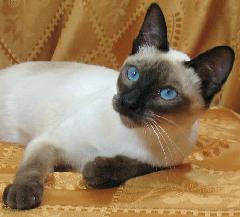 |
| Home | Kittens Available | Thai Queens | Thai Kings | Terms | Old-Style Siamese History |
| About Sarsenstone | Thai Breed | A Word About FIP | Matters of Conscience | Cats of Thailand |
|
SARSENSTONE
CATTERY Are Appleheads Really Shaped Like Apples?
|
The word "applehead" is often used nowadays to refer to the Old-Style Siamese (Thais in TICA), which gives people the idea that these cats should have heads shaped like apples, round as can be. Most people would call the Old-Style Siamese stud above right an applehead, but babies tend to "fill out" as they mature, and unneutered males develop large jowls that pad their cheeks and jaws. At left is the same stud as a 6 month old kitten. The modified wedge shape of the kitten's skull is obvious. So, are appleheads really shaped like apples? The term applehead was first coined as an insult. The Siamese breed was at an all-time high in popularity during the 1950s. Proud Siamese owners flocked to cat shows in large numbers to show off their beloved Siamese. The trend among the elite breeders at that time was toward increasingly lighter-built, finer-boned, longer-headed Siamese. The elite show cats back then were on average nowhere near as extreme as the modern Siamese shown today, but they were progressing in that direction. Suddenly the elite breeders found themselves at shows with scores of non-elite Siamese fanciers intent on exhibiting cats that were not part of the trend toward greater refinement of build. Those cats were chunkier than the elite show Siamese and they tended to have more rounding in the cheeks and jaws. The elite breeders dubbed them appleheads. Remember that that was an insult and was not intended to be an accurate description of the cats. Old-Style Siamese (Thais) today are often sons and daughters of cats imported directly into North America and Europe from Thailand. They also have old lines of Siamese in their pedigrees that retained the original look of the breed. These cats consequently look like the early Siamese first brought over the ocean from Siam between roughly 1880 and 1935. Here is a composite photo of Siamese cats that date from that time period: Now here is a composite photo of cats that are not Siamese, but which come from breeds that are known for their round heads: And here is a composite photo showing cats from breeds that are known for their extreme wedge-shaped heads and ultra-Oriental bodies: Finally, here are cats that come from breeds that are known for having modified wedge heads and moderate body type: Now consider this. There are two contributors to the shape of a cat's head. The first is the shape of the skull, such as how long or short, narrow or wide it is. The second contributor is the amount of flesh padding the head, especially on the cheeks and lower jaws. Mature, unneutered males of all breeds tend to have a lot of muscle on the jaws that rounds out the upper portion of the head. They are said to have "jowls." Females and neutered males that have a great deal of muscle or flesh on the body will tend to have more on the neck, cheeks, and jaws, as well. "Jowliness" is independent of the shape of the skull, but it modifies head shape. See the photo at the top of this page. Because jowliness is often just a function of individual musculature or whether the cat has been neutered or not, the shape of the feline head is primarily defined by the underlying skull shape, including the muzzle. A cat with a truly round head should have a very short head that lacks a prominent muzzle. The nose on a roundheaded cat is just decoration. A cat with a modified wedge head tends to have a medium to somewhat long head that is medium to wide in breadth. The muzzle of such a cat is a noticeable, but not extreme, extension of the head. A cat with an extreme wedge head tends to have a very long, very narrow head. The muzzle is a considerable appendage on the head and the lines of the wedge are so straight that it may be hard to tell where the main head leaves off and the muzzle begins. Cats with all three types of heads can have some extra flesh padding the jaws, but the padding is most evident on cats with modified wedge heads because those cats with medium wide, moderate heads will tend to look much rounder of head with the extra padding. The truly roundheaded cats always look round and the truly extreme wedgeheaded cats will never look round. Question: Are appleheads really shaped like apples? Answer: No. The so-called apple shape is really somewhere between a heart and a slightly flattened pear. The underlying shape of the skull is a modified wedge.
|
Copyright © 1996-2011 by Dr. Cris Bird of Sarsenstone Cattery. You may not redistribute it in any form without the express written consent of the copyright holder.